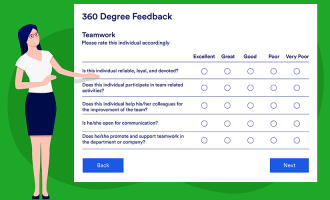Steps for conducting a team assessment
- Select the right software
- Design the assessment
- Collect assessment data
- Analyze the data
- Share feedback and results
If you’re a manager who’s noticed your team is struggling in areas like productivity, collaboration, or morale, it’s time to conduct a team assessment. But how do you carry this out?
As the saying goes, “You can’t improve what you don’t measure.” So, the first step in making progress is to benchmark your team’s current performance.
Here’s everything you need to know about benchmarking a team’s performance and building a framework for improvement.
The goal of team assessments
A team assessment is a method for systematically evaluating the health of a team or department, including their overall performance, the dynamics between team members and departments, and their overall effectiveness in completing projects and fulfilling their assigned functions.
Conducting a team assessment involves gathering data and feedback from team members and external stakeholders to gain insights into how the team functions, as well as identifying areas for improvement.
The goals of any team assessment include
- Performance improvement: Identifying any factors that contribute to or hinder a team’s effectiveness, efficiency, and results
- Team development: Gaining insight into team dynamics, communication patterns, and collaboration styles to improve understanding and cooperation
- Conflict resolution: Highlighting friction caused by interpersonal issues, communication breakdowns, and other disputes that need mediation
- Resource allocation: Ensuring individuals and teams are properly resourced and funded according to their responsibilities and expected output
- Goal alignment: Providing an opportunity to get every team member on the same page about expected results
The benefits of a team assessment
Regularly conducting a team assessment can be a lot of work, but it can also deliver incredible benefits to your organization — making it well worth the effort. Here are some key benefits of team assessments:
- Better performance outcomes: A team assessment paints a clear picture of your team’s strengths and weaknesses. Clearly identifying what needs improvement allows managers and individual team members to strategize ways to overcome these weaknesses, better positioning the team to achieve their goals in less time and with less energy and waste.
- Enhanced collaboration: A team assessment clarifies the roles and responsibilities of each individual on the team and for the team as a whole. When team members know what’s expected of them, they’re empowered to take more ownership over their part in a workflow and leverage each other’s skills and expertise.
- Higher employee engagement: When workers receive recognition for their contributions to a team, it inspires more focus and attention to detail at work. When you can identify weaknesses in a constructive manner, employees have an improvement goal to work toward and the motivation to succeed.
- Improved efficiency: A team assessment helps managers identify bottlenecks and redundancies, providing them the opportunity to correct these issues with better resource allocation and process design.
Areas to evaluate during a team assessment
Team assessments can occur at any time of year and at any frequency. However, it’s important not to overanalyze performance. Team assessments should occur at a sustainable frequency. Additionally, focusing on specific areas of assessment will prevent managers from generating unnecessary data and feedback.
Here are some ideas about what to evaluate:
- Performance and results: Assess how effectively the team achieves its goals, and track key performance indicators, productivity, and efficiency.
- Communication effectiveness: Evaluate the quality, frequency, and clarity of communication within the team, as well as how it helps or hinders efforts to achieve goals. Also, look at how well team members share information and provide feedback for each other.
- Fulfillment of roles and responsibilities: Assess how well employees understand their individual roles and responsibilities within their team, how well their roles align with their natural skills and expertise, and how well each individual understands the roles and responsibilities of their team members.
- Decision-making ability: Assess the processes teams use to make decisions, as well as how quickly and efficiently they make decisions and whether or not decision-making involves the correct stakeholders.
- Leadership and support: Assess how effectively leaders provide clear guidance on projects, adequate support for employees, and proper resource allocation. Also consider the culture they foster with their leadership approach.
Steps for conducting a team assessment
Conducting a team assessment can be a large undertaking. It requires a systematic approach to collect and use data. Fortunately, the right digital tools and software solutions, like survey builders, can streamline and simplify the process. Here’s how to use software to conduct a team assessment:
- Select the right software. Get a clear understanding of your needs from a team assessment and select software that aligns with your goals and requirements. Consider factors such as survey capabilities, data analysis features, and user-friendliness.
- Design the assessment. Follow your software’s instructions to design your assessment survey. Customize the questions according to what you want to evaluate, and remember to use a mix of question types to get a variety of feedback.
- Collect assessment data. Set up your software to automatically collect and organize employee submission data in a single, accessible place.
- Analyze the data. When everyone has submitted feedback, export survey data in a suitable format for in-depth analysis. Many software platforms offer built-in reporting and analysis features, such as the ability to generate charts and statistical summaries, so it’s easy to glean insight from the responses.
- Share feedback and results. Use the software to prepare reports and submit them to team members through the desired channels. Remember to provide feedback in a constructive manner and frame everything in terms of growth opportunities to maximize engagement.
Powerful team assessments with Jotform
The best software for conducting a team assessment will allow you to create professional, custom surveys with no coding experience and enable team members to easily submit their feedback. Online form builder Jotform features these benefits and more.
Jotform allows users to design comprehensive assessment forms with a wide array of question types, like multiple choice and open-ended questions. Best of all, users can customize over 10,000 form templates, including human resources and employee evaluation forms, so they don’t have to design surveys from scratch.
Team members can conveniently submit their responses from any device through Jotform’s flexible, mobile-friendly forms. Survey responses are automatically logged in Jotform Tables, eliminating manual data entry and streamlining the data analysis process.
Ready to prepare a team assessment? Use our team assessment survey template to start an evaluation.
















































































Send Comment: